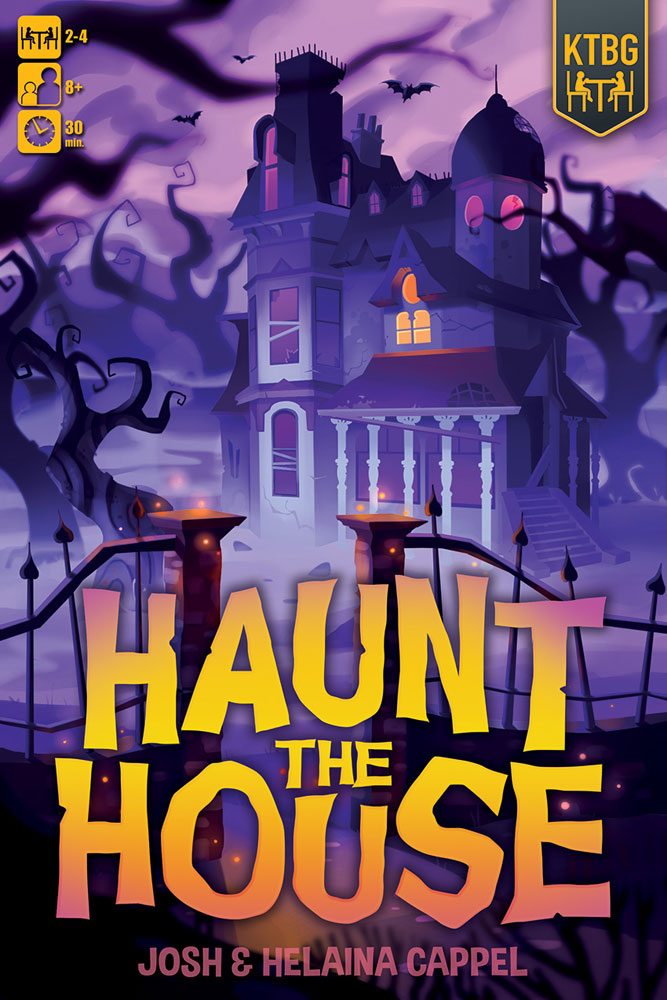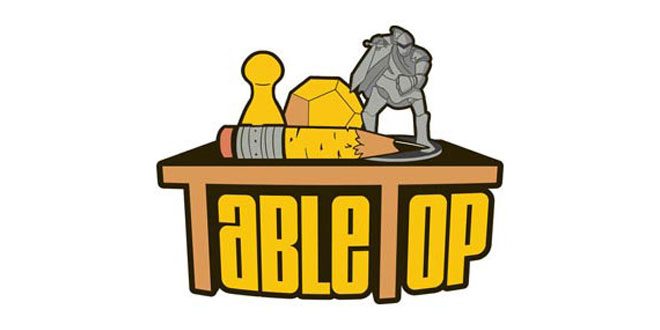Everyone says that mansion up on the hill is haunted, so it’s a popular spot for ghost hunters, there to capture evidence of spooky specters—that’s you! Scare away the ghost hunters and collect their gear as trophies. It’s time to Haunt the House!
What Is Haunt the House?
Haunt the House is for 2 to 4 players, ages 8 and up, and takes about half an hour to play. It’s currently seeking funding on Kickstarter, with a pledge level of $29 CAD (~$23 USD) for a copy of the game, or $39 CAD (~$31 USD) for the Darker Corners deluxe edition. (Shipping costs aren’t included in the pledge amount.) Although the theme is a haunted house, the artwork is kid-friendly and more whimsical than creepy. There are simple and advanced rules, so you can adjust the game based on experience level.
New to Kickstarter? Check out our crowdfunding primer, and visit our Kickstarter curated page for more projects we love.
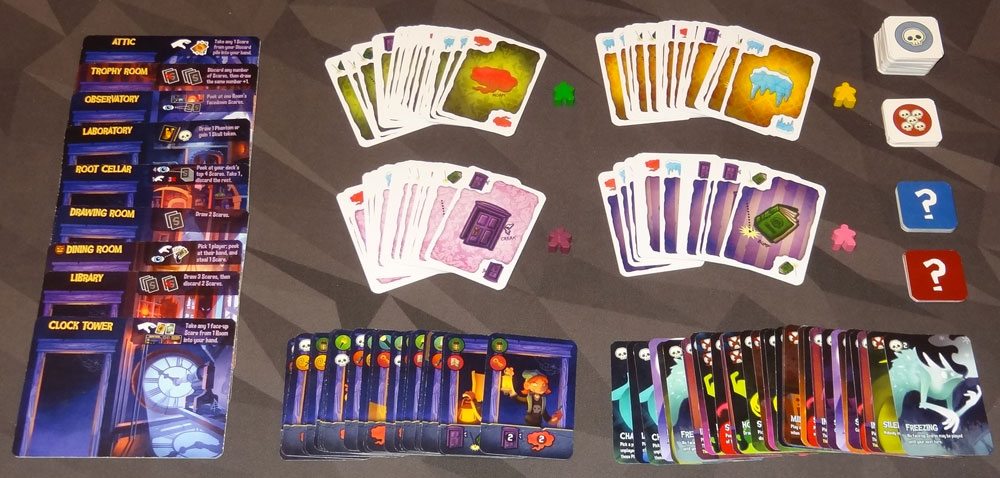
Haunt the House Components
Note: my review is based on a Kickstarter prototype so component quality is not final. Art and design looks mostly finished, but can be subject to change—for instance, the card backs in my prototype do not match what’s shown on the Kickstarter page, and the wooden ghost markers may be changed from standard meeples to custom ghost shapes if stretch goals are reached.
- 64 Scare cards (16 per player, each with 4 Moans, 4 Chills, 4 Creaks, and 4 Bumps)
- 24 Ghost Hunter cards
- 38 Skull tokens (in 1 skull and 5 skull values)
- 9 Room tiles
- 30 Phantom cards
- 8 Trophy tiles
- 4 Ghost markers

The scare cards each show a large symbol representing the scary things you can do as a ghost: a bouncing book for “bump,” a blue cloud with icicles for “chill,” and so on. The backs of the cards are all the same, but the fronts have different colored backgrounds so you can separate them out in the different player colors. The backgrounds also have different wallpaper patterns, making it better for color blind players as well.
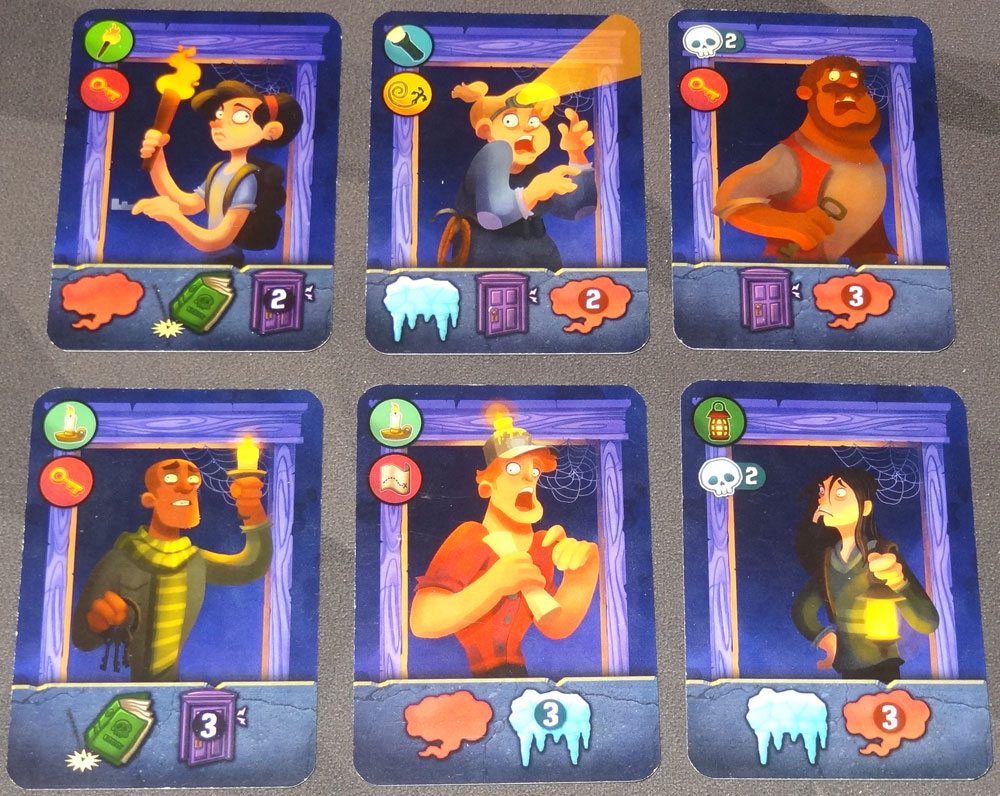
The ghost hunters are all depicted in doorways, which fit onto the empty doorway spot of the room tiles. The ghost hunters all look scared, and the artwork is perfect for the game. Each of the room tiles has the doorway, and then an illustration of the room itself, along with a special ability associated with the room.
The phantom cards are used in the advanced rules, and there’s a host of different phantoms that are all really fun to look at.
The Kickstarter edition will have an exclusive box that glows in the dark!
My review copy did not include the additional components for the Darker Corners deluxe edition, which will add:
- 4 Room tiles
- 8 Phantom cards
- 16 Scare cards with a twist
- 4 more challenging Ghost Hunters
More information about these will be revealed later during the campaign.
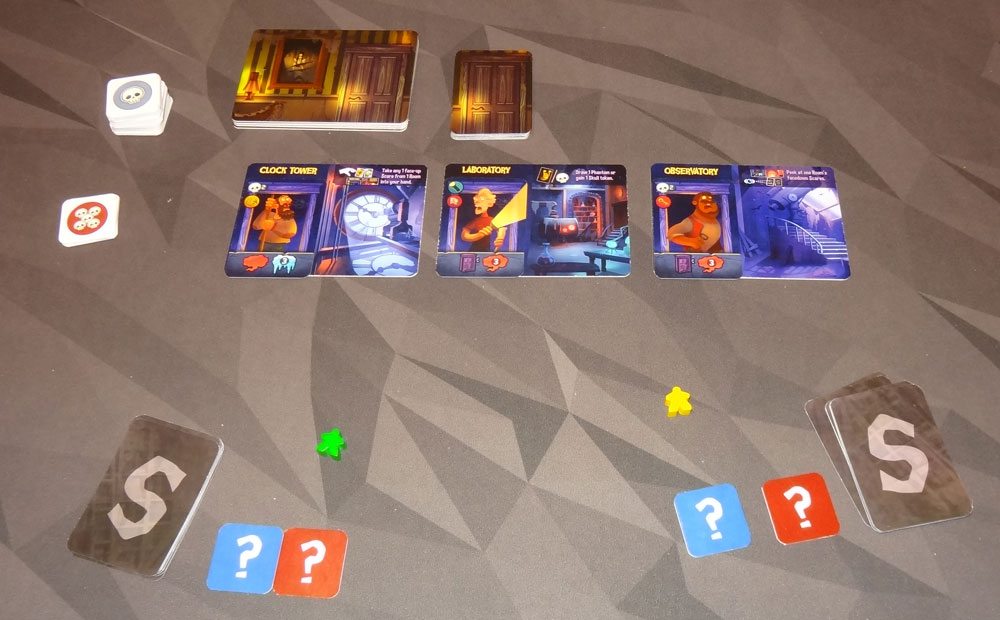
How to Play Haunt the House
The Goal
The goal of the game is to score the most points by collecting trophies from the ghost hunters and skull tokens.
Setup
Give each player a ghost marker and the scare cards of the matching color, which should be shuffled. Each player also takes one blue trophy token and one red trophy token at random without revealing them to other players.
Shuffle the room tiles and the ghost hunter cards. Place four rooms (three in a 2-player game) on the table, and place one ghost hunter on each room. Each ghost hunter has some icons on the bottom indicating what combination of scares will chase it away, and some icons at the upper left that show what equipment it is carrying.

Gameplay
On your turn, you either take 2 actions or yell Boo! Then, if you have not successfully scared any ghost hunters, you may discard any number of cards and then draw back up to 3 cards.
Take 2 Actions
You have three choices for actions:
- If you have 0 or 1 scare in your hand at the start of your turn, you may use your first action to draw back up to 3 scares.
- You may play any scare card face-down next to a room, even if it doesn’t match the scare symbols on the ghost hunter.
- You may play a scare card face-up next to a room only if it is still needed to scare the ghost hunter, and then you may immediately trigger the room’s ability.
You must take exactly 2 actions, and you can take options 2 and 3 in any order, or twice.
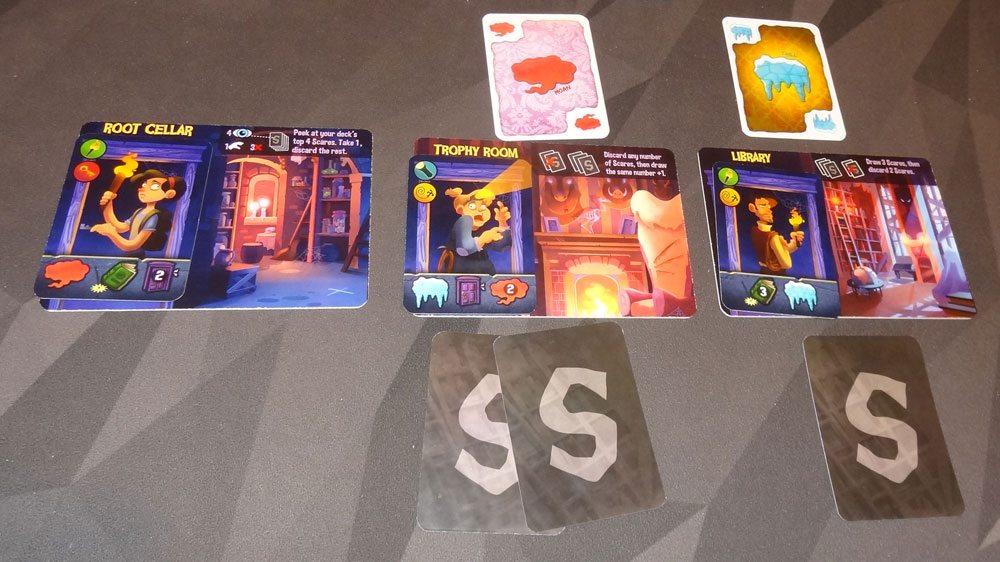
Yell Boo!
If you think there are enough scares to frighten a particular ghost hunter, you can yell “Boo!” You pick the ghost hunter you want to scare. First, reveal the face-down cards. Each player who played a face-down card that matches the ghost hunter (even if there are more than required) gets 1 skull token. Discard any incorrect scares to the appropriate players’ discard piles.
Then compare all of the scares to the ghost hunter’s requirements and see if there are enough. If not, you may also add scares from your hand to complete the requirements. If you have enough scares, the ghost hunter is scared off! You take the ghost hunter and add it to your scoring pile, then remove the room and replace it with a new room and a new ghost hunter.
If there aren’t enough scares, the scares that had been played face-down are all discarded (leaving only the face-up scares) and your turn ends.
Draw Scares
If you did not successfully scare a ghost hunter on your turn (either because you took actions or you yelled “Boo!” unsuccessfully), then you get to discard any number of cards and draw back up to 3 scares. If you successfully scared a ghost hunter, you do not draw anything.

Game End
When any player has scared four ghost hunters (5 in a 2-player game), each other player in turn order gets one chance to yell “Boo!” or pass, and then the game ends.
Each skull token and skull icon on a ghost hunter is worth 1 point. Each equipment icon on a ghost hunter or on a trophy tile is worth points equal to the number of icons you have. So if you have 3 flashlights, they’re each worth 3 points, so a total of 9. Add up all your points, and the highest score wins!

Phantoms
The advanced rules introduces the phantom cards. Shuffle these and set them nearby.
When you have correct face-down cards revealed during a yell “Boo!” action, you place your ghost marker on the phantom deck. Then, after the “Boo!” is resolved, each player in turn order who has a ghost marker on the phantom deck may choose to get a skull token or draw 2 phantoms and keep 1 of them.
Phantoms have various effects, and you may play one phantom on your turn, either before, between, or after your two actions. You may not play phantoms when you yell “Boo!” The phantom card doesn’t count as an action, and doesn’t count toward your 3 cards when you draw back up.
Phantoms are left face-up in front of you after played. Some of the phantoms show skulls or crossed-out skulls. At the end of the game, you will gain or lose skulls for the cards you have played; any cards remaining in your hand do not count for points.
Why You Should Play Haunt the House
Haunt the House is a fun mix of set collection and bluffing, and gives you some good options and sometimes difficult choices to make. It’s the sort of game that will be great for a Halloween game night, though (alas) you’ll have to wait until next year for that because it’s only on Kickstarter now. I like the idea of playing as the ghosts rather than the ghost hunters; you can imagine knocking books off shelves and pushing creaky doors to spook the folks invading your home.
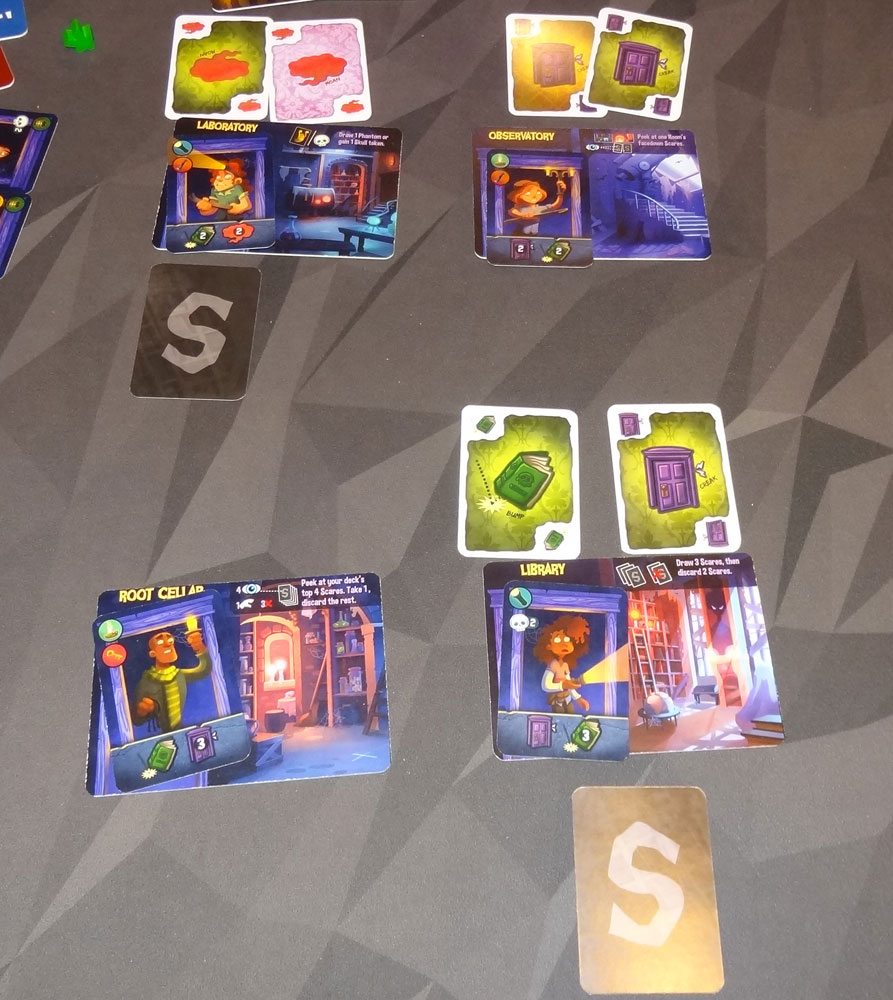
One of the main actions that drives the game, of course, is playing scare cards. These accumulate on a ghost hunter until they’re scared enough to be chased away. But your choices when you play a scare card are whether to play something face-up or face-down, and whether to play a scare that’s needed or one that doesn’t do anything. Playing one face-up gets you a powerful room ability, and sometimes those are really hard to pass up. On the other hand, a face-up card must match, and you’re basically helping everyone else scare that particular hunter.
Playing a correct card face-down also helps everyone who wants to scare that hunter, but you’re the only one who knows for sure. And if you suspect that another player may yell “Boo!” on a particular hunter, getting a correct card in before that happens will score you a skull, at least, even if you’re not getting points for the hunter’s trophies. In one game I played, another player managed to get 8 skull points—not insignificant when the highest score was 27 points—just by putting correct scares face-down throughout the game.
And, of course, you can bluff by playing an incorrect scare face-down. Maybe all those face-down scares will tempt somebody to waste their turn yelling “Boo!” so that you can buy yourself more time to get the right cards in hand!
The timing of yelling “Boo!” can also be tricky. You don’t get to draw back up when you scare a hunter successfully, so you always hope there are enough scares already so you don’t have to spend any from your hand. When you have all the correct scares to finish off a hunter, do you play them (face-up or face-down) and yell “Boo!” next turn, so that you’ll have a full hand of scares after? If you place them, another player might yell “Boo!” before you, using your scares to earn points. Or do you just yell “Boo!” now, guaranteeing that you claim the ghost hunter—at the cost of starting your next turn with fewer cards?
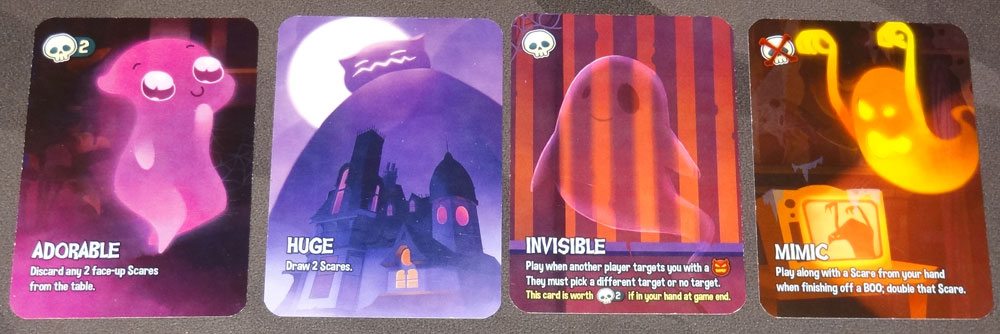
(Prototype shown) Photo: Jonathan H. Liu
The phantom cards add a nice second layer to the game, giving you sneaky abilities and another way to earn points. Some cards are very powerful, but will cost you points if you play them, so you have to make sure that you’re gaining at least as much as you’re losing by playing the card. Do you take the guaranteed skull, or take your chance on a phantom instead? Either way, the introduction of phantoms tends to encourage more face-down cards, because that’s the only way to get phantoms. On the other hand, because there are more face-down cards, there are also more opportunities to bluff.
Kids Table Board Gaming has stated that their goal is to make games that are “great for adults to play with kids, for kids to play with other kids, and even for adults to play with other adults.” I think Haunt the House fits that description pretty well; it’s one that I’ve played with both my 10-year-old daughter and adult friends. If you’ve got kids (or fellow adult gamers) who like haunted houses and casual games, I’d recommend taking a look at Haunt the House.
For more about the game or to make a pledge, visit the Haunt the House Kickstarter page!
Click here to see all our tabletop game reviews.
Disclosure: GeekDad received a prototype copy of this game for review purposes.

